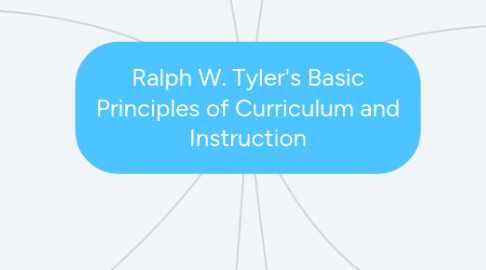Ralph W. Tyler's Basic Principles of Curriculum and Instruction
by Michaela Presley


1. Tyler's theory shows to be both linear and holistic ways of looking at curriculum.
1.1. Linear: This theory is linear because it starts at the beginning and gives steps in a process that ultimately leads to an end goal.
1.2. Holistic: This theory looks at the institution as a whole. It is a revolving circle that starts as objectives, ends in evaluation, and further leads to improved objectives.
1.3. Tyler's theory looks at both sides of the questions: Where are we headed? How will we get there?
1.3.1. This theory looks at what the expected outcomes will be along with building the curriculum to get the students to that point.
2. References:
2.1. Schugurensky, D. (n.d.). Ralph W. Tyler Publishes Basic Principles of Curriculum and Instruction. In History of Education: Selected Moments of the 20th Century. Retrieved from schugurensky.faculty.asu.edu
2.2. Oliva, P., Taylor, ., & Gordon, W. (2013). Developing the Curriculum (8th ed.th ed.). N.p.: Pearson Education.
2.3. Denham, T.J., & Morrison, E. E. (2002, February). Comparison of two curriculum/instructional design models. Retrieved from http://files.eric.ed.gov/fulltext/ED471734.pdf
3. Reflection of Theory: Tyler's theory, in my opinion, is extremely well thought out and beneficial to students and individuals. He focused on the ways in which individuals learn. His focus is on what interests students, how to implement that into learning, and analyzing that information.
3.1. This theory is productive because it is like a revolving door. They base learning off of what the students are interested in, analyze them, and re-evaluate that information if something wasn't connecting with students. It's an always improving process to put the student's needs first.
4. "Ralph W. Tyler was an American educator who worked in the field of assessment and evaluation. He served on or advised a number of bodies that set guidelines for the expenditure of federal funds and influenced the underlying policy of the Elementary and Secondary Education Act of 1965."
5. The Tyler rationale was developed by Ralph W. Tyler as a "process for selecting educational objectives." This model created a basis for curriculum (Oliva, Taylor, & Gordon 2013).
6. Tyler was often known as the "grandfather of curriculum design." He was heavily influenced by men such as Thorndike and Dewey. Tyler was born April 22, 1902, in Chicago, Illinois, and soon moved to Nebraska in 1904.
6.1. Thorndike turned curriculum from the "relative values of different subjects to empirical studies of contemporary life" (Denham & Morrison, 2002).
6.2. Dewey focused on the idea of ensuring that student's interests were being incorporated into learning objectives and activities (Denham & Morrison, 2002).
7. Tyler's theory for the principles of curriculum are based on 4 main points: (Schugurensky)
7.1. 1. Defining appropriate learning objectives.
7.1.1. What do the students need in order to be successful?
7.2. 2. Establishing useful learning experiences.
7.2.1. "The most difficult problem is setting up learning experiences to try to make interesting a type of activity which has become boring or distasteful to the student" (Denham & Morrison, 2002).
7.3. 3. Organizing learning experiences to have a maximum cumulative effect.
7.3.1. "Organization is seen as an important problem in curriculum development because it greatly influences the efficiency of instruction and the degree to which major educational changes are brought about in the learners" (Denham & Morrison, 2002).
7.4. 4. Evaluating curriculum and revising those aspects that did not prove to be effective.
7.4.1. "What is the purpose of this assessment - what do you want it for?" (Denham & Morrison, 2002)

